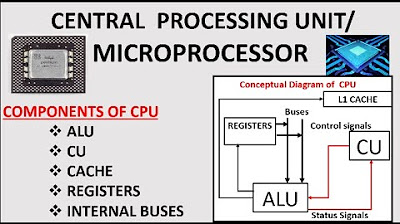CPU ou Unidade Central de Processamento
Summary
TLDRThis video explains the essential components of the CPU (Central Processing Unit) in detail. It covers the Control Unit (CU), responsible for managing data flow and instructions, and the Arithmetic and Logic Unit (ALU), where actual data processing and calculations occur. It also discusses the role of Registers, which are fast but limited memory spaces used for temporary data storage. The script highlights how these parts work together in the CPU and touches on important concepts like memory types (Cache, RAM) and clock speed. Ideal for students seeking a comprehensive understanding of CPU functions.
Takeaways
- 😀 The CPU, or Central Processing Unit, is the main processor of the computer and is located on the motherboard in a specific socket for CPUs.
- 😀 The CPU can be referred to as UCP (Unidade Central de Processamento) in Portuguese or simply as the processor, but all terms refer to the same thing.
- 😀 The CPU is known as the central unit because it is responsible for processing data centrally in the machine.
- 😀 The Control Unit (Unidade de Controle) within the CPU does not process data but commands and controls the processing of data by interpreting instructions from programs.
- 😀 The Control Unit also manages the input and output of data, directing data flow between the CPU and input/output peripherals, such as keyboards and monitors.
- 😀 The Arithmetic and Logic Unit (ALU) is the part of the CPU that performs the actual processing of data, including arithmetic calculations and logical comparisons.
- 😀 ALU handles the core operations of the CPU, while the Control Unit orchestrates and supervises the flow of processes and data.
- 😀 The CPU contains registers (or registros), which are small, volatile, and fast memory areas used to store temporary data and results.
- 😀 Registers are the fastest memory in a computer, but their storage capacity is minimal. They are volatile, meaning they lose data when power is lost.
- 😀 In the context of the CPU, the role of registers is to store and temporarily hold data and results that are being processed by the ALU.
- 😀 Important terminology, like clock speed (measured in Hertz) and chipset, was also explained, with the clock representing the CPU’s processing frequency, and the chipset managing communication between peripherals and the CPU.
Q & A
What does CPU stand for, and what is its function?
-CPU stands for Central Processing Unit. It is the main processor in a computer responsible for processing data and executing instructions from various programs.
What is the role of the Control Unit (CU) in the CPU?
-The Control Unit (CU) manages and controls the flow of data within the CPU. It interprets instructions from programs and ensures that data is processed correctly, controlling input and output data interactions with peripherals.
How does the Arithmetic and Logic Unit (ALU) function within the CPU?
-The Arithmetic and Logic Unit (ALU) is responsible for performing arithmetic operations (like addition and subtraction) and logical comparisons (like AND, OR) on the data processed by the CPU.
What are registers in the CPU, and how do they work?
-Registers are small, high-speed memory units within the CPU used for temporarily storing data and results while being processed. They are volatile, meaning their content is erased when the computer is turned off.
Why are registers considered the fastest memory in a computer?
-Registers are the fastest memory because they are located directly within the CPU and can be accessed much quicker than other types of memory, like RAM or cache memory.
What is the main limitation of registers in the CPU?
-The main limitation of registers is their small storage capacity. While they are fast, they can only hold a limited amount of data at any given time.
What is the function of the Clock in the CPU?
-The Clock in the CPU dictates the frequency of processing, which is measured in cycles per second (Hertz). It ensures the synchronization of all CPU operations by providing timing for each cycle of data processing.
What is the role of the Chipset on the motherboard?
-The Chipset is a set of chips that acts as an intermediary between the CPU and other peripherals on the motherboard, facilitating communication between the CPU and external components.
What are the key components of the CPU mentioned in the transcript?
-The key components of the CPU mentioned in the transcript are the Control Unit (CU), Arithmetic and Logic Unit (ALU), registers, and the Clock.
What does the acronym UCP stand for, and how is it related to CPU?
-UCP stands for 'Unidade Central de Processamento' in Portuguese, which translates to Central Processing Unit (CPU) in English. UCP and CPU refer to the same component, the main processor of the computer.
Outlines

Cette section est réservée aux utilisateurs payants. Améliorez votre compte pour accéder à cette section.
Améliorer maintenantMindmap

Cette section est réservée aux utilisateurs payants. Améliorez votre compte pour accéder à cette section.
Améliorer maintenantKeywords

Cette section est réservée aux utilisateurs payants. Améliorez votre compte pour accéder à cette section.
Améliorer maintenantHighlights

Cette section est réservée aux utilisateurs payants. Améliorez votre compte pour accéder à cette section.
Améliorer maintenantTranscripts

Cette section est réservée aux utilisateurs payants. Améliorez votre compte pour accéder à cette section.
Améliorer maintenant5.0 / 5 (0 votes)






